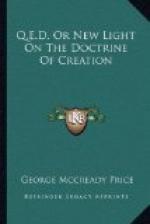We may illustrate the matter by comparing this series with a card index. The earlier students of geology arranged the outline of the order of the fossils by a rather general comparison with the series of modern life forms, which happened to agree fairly well with the order in which they had found the fossils occurring in England and France. But only a block out of the middle of the complete card index could be made up from the rocks of England and France; the rest has had to be made up from the rocks found elsewhere. Louis Agassiz did herculean work in rearranging and trimming this fossil card index so as to make it conform better, not only to the companion card index of the modern forms of life, but also to that of the embryonic series. From time to time even now readjustments are made in the details of all three indexes, the fossil, the modern, and the embryonic, the method of rearrangement being charmingly simple: just taking a card out of one place and putting it into another place where we may think it more properly belongs. And then if we can convince our fellow scientists over the world that our rearrangement is justified, our adjustment will stand,—until some one else arises to do a better job. When a new set of rocks is found in any part of the world it is simplicity itself for any one acquainted with the fossil index system to assign these new beds to their proper place, though of course the one doing this must be prepared to defend his assignment with pertinent and sufficient taxonomic reasons.
In view of these facts, we need not be concerned as to the fate of the geological classification of the fossils. It is a purely artificial system, just as is the modern classification; but both are useful, and so far as they represent true relationships they will both stand unaffected by any change we may make in our opinions as to how the fossils were buried. But in view of this purely artificial character of the geological series, what a strange sight is presented by the usual methods employed to “prove” the exact order in which evolution has taken place, such for instance as the use made of the graded series of fossil “horses,” to illustrate some particular theory of just how organic development has occurred. One might just as well arrange the modern dogs from the little spaniel to the St. Bernard, for the geological series is just as artificial as would be this of the dogs.
2. Another conclusion from the facts enumerated above is that there has obviously been a great world catastrophe, and that this must be assigned as the cause of a large part,—just how large a part it is at present difficult to say,—of the changes recorded in the fossiliferous rocks. This sounds very much like a modern confirmation of the ancient record of a universal Deluge; and I say confidently that no one who will candidly examine the evidence now available on this point can fail to be impressed with the force of the argument for a world catastrophe as the general conclusion to be drawn from the fossiliferous rocks all over the globe.




